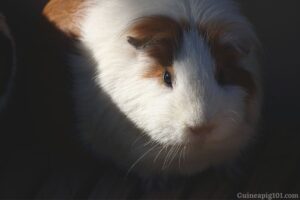Guinea pig breathing process
The nasal cavity of the guinea pig, which is located inside their nose, is located dorsal to their mouth. Located between the mouth and the nasal cavity, the soft and hard palates are divided into two sections. The palate is referred to as the “roof of the mouth.” The hard palate is located in the front region of the roof of the mouth, and the soft palate is located in the back region.
The nasal cavity is separated into two parts: the left side and the right side, with a cartilage barrier separating them in the middle. It is covered with fine hairs on its inner surface, which aids in air purification by collecting dust as it enters the nasal cavity and then travels to the respiratory tract.
Guinea pigs have sensory pads at the opening to their nostrils, which makes their noses responsive to touch and makes them more intelligent. Once the body is entirely relaxed, the nostrils become completely still. The nostrils of a guinea pig can twitch up to 100 times each minute.
Given that guinea pigs have a keen sense of smell, they twitch their noses to enable more air to enter and allow the scent-detecting organs in their nostrils to function more effectively. Furthermore, it enables them to capture even the tiniest traces of odour in the atmosphere.
When guinea pigs breathe, their alar folds open up, allowing air to pass through their nostrils and into their stomach. Afterwards, the air travels through the nasal cavity, the trachea, and the larynx before finally entering the lungs.
The larynx is the name given to the guinea pig’s voice box, while the trachea is a lengthy tube that is found in the guinea pig’s respiratory system and is encircled by cartilaginous rings to aid in breathing. These rings assist in preventing the tube from collapsing when air is drawn in and out of the tube.
The trachea is subsequently divided into two airways, which are known as the left and right bronchus, respectively.
At the hilum, these two bronchi come together to form a single tube. The bronchi are then gradually separated into narrower branches known as bronchioles, which branch off into the respiratory bronchioles and finally terminate at the alveolar ducts, as shown in the diagram.
Guinea pigs also have a muscular tissue known as a diaphragm, which is located beneath the lungs and allows them to breathe. To aid respiration, the membrane’s job is to contract and relax at regular intervals.
Why guinea pigs breathe through their nose?
Because guinea pigs breathe via their noses, they are unable to breathe through their mouths. The epiglottis of guinea pigs is implanted at the backmost portion of the soft palate, and this becomes the principal cause for them to breathe via their noses after birth. The soft palate is the portion of the roof of the mouth that is located on the posterior.
The epiglottis has a role in preventing food from entering the air passageways while swallowing. Guinea pigs are able to breathe while eating because of the separation produced by the soft and hard palates on their tongues.
An extra layer of tissue exists inside the guinea pigs’ mouths that rests on top of the glottis, which is the entry to their throat.
The tissue’s primary job is to prevent air from passing through the mouth and into the trachea.
If guinea pigs inhale through their mouths, the air will not make its way into their lungs in any way.
Are guinea pigs obligate nasal breathers
Nasal breathers include a variety of animals including rabbits, horses, rodents, and human neonates, amongst other things. Obligate nasal breathers can be characterized as those who are physically compelled to breathe through their nose rather than through their mouth.
As a result, it can even generate misunderstanding because it claims that an obligate nasal breather can only breathe through their nose, which is not true in reality.
Even though an obligatory nasal breather has the ability to breathe via their mouth, they prefer to do it through their nose. Comparing mouth breathing to nose breathing in animals such as guinea pigs, mouth breathing is less successful.
The capacity to breathe via the nose while eating is referred to as “obligate nasal breathing.”
Obligate nasal breathing is a type of adaptation that can be found in prey animals such as guinea pigs, which can be described as follows: It facilitates guinea pigs’ ability to consume food as well as their ability to quickly identify the odors of predators.
How many breaths per minute is normal for a guinea pig?
The number of breaths taken per minute is referred to as the respiratory rate in this context. Guinea pigs have a respiratory rate ranging from 42 to 105 breaths per minute on average.
It is possible to determine the respiratory rate of your guinea pigs by counting the number of breaths that they take in 15 second intervals.
You can then multiply this number by four to get the final result. The rising of the guinea pig’s chest can also be used to determine how well they are breathing.
Place your hand in front of their nose and count the number of times they exhale while doing this too.
If you observe that your guinea pig is breathing rapidly, it could be due to stress or overheating in the environment.
Is it normal for guinea pigs to breathe fast?
If you notice that your guinea pigs are breathing more quickly than usual, but are otherwise acting, eating, drinking, pooping, and eliminating normally, there is no reason to be concerned.
We recommend that you relocate your guinea pigs to a more peaceful and cooler environment with plenty of fresh drinking water.
When your guinea pigs are breathing rapidly, the following table will tell you if they are fine or whether they require veterinarian assistance.
| Good Signs | Bad Signs |
|---|---|
| Quick Breathing | Quick Breathing |
| Eating normally | Labored breathing |
| Pooping normally | Mouth-breathing |
| Friendly and calm nature | Nervous movement as they are in pain |
| Joyful as usual | Acting scared |
| Drinking normally | Staying Hunched |
| Eliminating normally | Not being able to move |
| Normal surrounding temperature | You will discover them grunting |
Heatstroke can occur as a result of too fast breathing. According to studies, guinea pigs suffer from heatstroke when their body temperature rises to a point where blood flow to the brain is restricted, ultimately resulting in the death of the animals.
If you notice your guinea pigs breathing fast and twitching their nose, as well as some other signs such as the ones listed below:
- Lethargy
- Tossing of the head
- Ears & feet turns warm
- Open-mouth breathing
- Restlessness
- Lack of appetite
They may be suffering from hyperthermia, in which case they should seek medical assistance immediately, if this is the case.
We will recommend that you never overlook such symptoms because doing so may result in your guinea pig developing a serious health condition.
Do guinea pigs breathe from their mouth?
The practice of mouth breathing, according to some research, may be indicative of an obstruction in the upper airway. That can result in severe dyspnea (shortness of breath), which can be manifested by increased respiratory effort and wheezing, among other symptoms.
It is possible that your guinea is suffering from dental problems, such as odontogenic abscesses, if he is breathing via his mouth. As a result of the infection, upper respiratory sickness and rhinitis may occur as consequences.
Humans can maintain their breathing by breathing through their mouths, which is particularly useful in situations where breathing through the nose is not possible, such as while suffering from an upper respiratory tract infection (RTI) ( Respiratory tract infection).
Guinea pigs, on the other hand, are not the same as humans because they are physiologically compelled to breathe through their noses.
If your guinea pigs are breathing too quickly or too slowly, or if they are making weird noises when they breathe, they may need to be taken to the veterinarian right away.
Conclusion
Because guinea pigs are nose breathers by nature, they are unable to breathe through their mouths. They can only take in air through their nostrils. Guinea pigs have a respiratory rate ranging from 42 to 105 breaths per minute on average.
If you notice that your guinea pigs are breathing fast and twitching their nose, they should be taken to the veterinarian right away. Guinea pigs might suffer from heatstroke if they breathe too quickly.
Finally, we would encourage you to take good care of your piggie and to show them as much affection and attention as possible. Apart from that, always keep an eye on them because, as prey animals, they will attempt to conceal any troubles they are experiencing.




